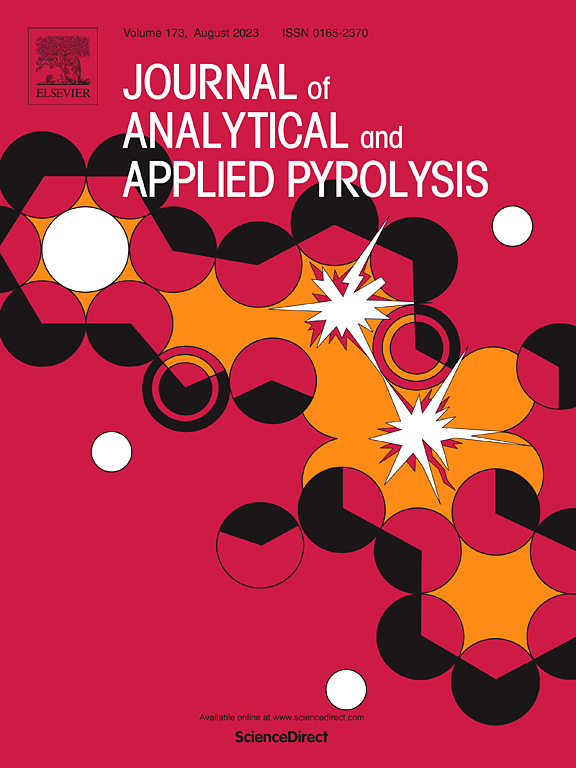探讨了ZnO在二甲基甲基环己基-2,4-二氨基甲酸酯热解中催化性能的影响因素及其催化机理
IF 6.2
2区 化学
Q1 CHEMISTRY, ANALYTICAL
引用次数: 0
摘要
二甲基环己基-2,4-二氨基甲酸酯(HTDC)的热解是高选择性非光气合成甲基环己基-2,4-二异氰酸酯(HTDI)的重要步骤之一。在这项工作中,我们发现两种商业ZnO样品在HTDC热解反应中表现出明显的催化性能。通过XRD、SEM、TEM、N2吸附-解吸、XPS、TG/DSC等催化剂表征,确定了ZnO样品的粒径、比表面积、暴露晶面、氧空位浓度是影响其催化性能的主要因素。在此基础上,通过原位FTIR分析和第一性原理计算对zno催化HTDC热解反应过程进行了阐述。以上研究表明,选用氧空位浓度合适的ZnO催化剂,在反应过程中实现HTDI与反应体系的快速分离,是实现HTDI高选择性合成的关键。HTDC的热解主要是通过氨基上的氢原子和甲氧基上的氧原子而不是羰基氧在ZnO表面吸附。而且由于甲基的位阻作用,对位氨基甲酸甲酯基团比邻位氨基甲酸甲酯基团更容易被热解。为HTDC高选择性热解制HTDI开辟了一条新途径。本文章由计算机程序翻译,如有差异,请以英文原文为准。
Probing into the factors influencing the catalytic performance of ZnO and its catalytic mechanism in dimethyl methylcyclohexyl-2,4-dicarbamate pyrolysis
The pyrolysis of dimethyl methylcyclohexyl-2,4-dicarbamate (HTDC) is one of the most important steps in the highly selective synthesis of methylcyclohexyl-2,4-diisocyanate (HTDI) through the non-phosgene route. In this work, we found that two commercial ZnO samples showed a distinct catalytic performance in HTDC pyrolysis reaction. With the aid of catalyst characterizations of XRD, SEM, TEM, N2 adsorption-desorption, XPS, TG/DSC, etc, we are convinced that particle size, specific surface area, crystal plane exposed, and oxygen vacancy concentration are responsible for the catalytic performance of ZnO sample. On this basis, ZnO-catalyzed HTDC pyrolysis reaction process was elucidated by the analyses from both in-situ FTIR and the first-principles calculations. The above investigations demonstrated that employing the ZnO catalyst with suitable oxygen vacancy concentration and achieving a rapid separation of HTDI from the reaction system in the reaction process are the keys to attaining highly selective synthesis of HTDI. The pyrolysis of HTDC proceeds by a predominant adsorption on the ZnO surface through the hydrogen atom of the amino group and the oxygen atom of the methoxy group rather than the carbonyl oxygen. And what’s more, the methyl carbamate group in the para-position is pyrolyzed prefercially compared with that in the ortho-position due to the effect of the steric hindrance of methy group. This work paved a new way to highly selective pyrolysis of HTDC to HTDI.
求助全文
通过发布文献求助,成功后即可免费获取论文全文。
去求助
来源期刊
CiteScore
9.10
自引率
11.70%
发文量
340
审稿时长
44 days
期刊介绍:
The Journal of Analytical and Applied Pyrolysis (JAAP) is devoted to the publication of papers dealing with innovative applications of pyrolysis processes, the characterization of products related to pyrolysis reactions, and investigations of reaction mechanism. To be considered by JAAP, a manuscript should present significant progress in these topics. The novelty must be satisfactorily argued in the cover letter. A manuscript with a cover letter to the editor not addressing the novelty is likely to be rejected without review.

 求助内容:
求助内容: 应助结果提醒方式:
应助结果提醒方式:


